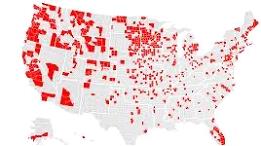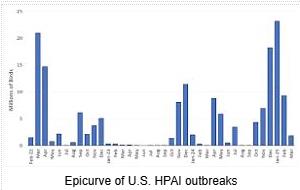On December 11th, senators representing both sides of the aisle addressed a letter to the White House urging adoption of vaccination as an adjunct to biosecurity to address the endemic and widespread incidence of highly pathogenic avian influenza (HPAI) manifest as an epornitic since 2021.

The group of 23 senators including Senate Majority Leader John Thune (R-SD), with Mike Rounds (R-SD) and Amy Klobuchar (D-MN), respectively Chair and Ranking Member of the Senate Committee on Agriculture, Food and Forestry, urged Brook Rollins, Secretary of Agriculture to implement “renewed action” to address the problem of HPAI. The letter stressed the need to apply science and to take into account the needs of all stakeholders. This implies balancing enhanced protection afforded to farmers against the possible loss of export markets for broiler leg quarters.
 The USDA is apparently developing a vaccination policy but has yet to release any document. In response to the letter, an unnamed USDA administrator noted, “Farmer biosecurity efforts are the most effective tool for mitigating the bird flu.” For the edification of this individual, HPAI can be introduced onto farms by the aerogenous route, effectively negating even the most stringent structural and operational biosecurity. The additional statement that USDA policy “Is grounded in decades of scientifically validated epidemiological practices and biosecurity protocols” is a self-validating misstatement of reality. The effectiveness of tactical preventive vaccination using a range of currently available commercial vaccines has proven effective in the industries of many nations including our southern neighbor. Essentially HPAI is the ‘Newcastle disease of the 2020s’. The infection was effectively controlled by immunization during the 1970s and is currently a problem only in nations without vaccination programs, defective vaccines or inappropriate administration.
The USDA is apparently developing a vaccination policy but has yet to release any document. In response to the letter, an unnamed USDA administrator noted, “Farmer biosecurity efforts are the most effective tool for mitigating the bird flu.” For the edification of this individual, HPAI can be introduced onto farms by the aerogenous route, effectively negating even the most stringent structural and operational biosecurity. The additional statement that USDA policy “Is grounded in decades of scientifically validated epidemiological practices and biosecurity protocols” is a self-validating misstatement of reality. The effectiveness of tactical preventive vaccination using a range of currently available commercial vaccines has proven effective in the industries of many nations including our southern neighbor. Essentially HPAI is the ‘Newcastle disease of the 2020s’. The infection was effectively controlled by immunization during the 1970s and is currently a problem only in nations without vaccination programs, defective vaccines or inappropriate administration.
 At the end of the first quarter of this year, as depopulation of large egg production complexes and turkey growing farms attained a high level, the USDA announced a “more-of-the-same” program funded by $100 million to “research vaccines and therapeutics.” More than 400 research proposals have been submitted to USDA to investigate aspects of HPAI. Even if the most promising of these avenues of research receive support, and achieve positive results it will not have any impact on the anticipated losses during seasonal migration of free-living birds during 2026 and 2027.
At the end of the first quarter of this year, as depopulation of large egg production complexes and turkey growing farms attained a high level, the USDA announced a “more-of-the-same” program funded by $100 million to “research vaccines and therapeutics.” More than 400 research proposals have been submitted to USDA to investigate aspects of HPAI. Even if the most promising of these avenues of research receive support, and achieve positive results it will not have any impact on the anticipated losses during seasonal migration of free-living birds during 2026 and 2027.
If the USDA has in fact developed a policy for vaccination then it should be released for review by the scientific community including epidemiologists and poultry health professionals in addition to flock owners, consumer advocates, exporters of poultry products and other stakeholders. There is concern that those advocating the status quo persist with their opposition to vaccination based on the potential impact on exports to the detriment of egg and turkey producers in high-risk areas. Inactivity is impacting adoption of preventive  vaccination consistent with endorsement by the World Organization for Animal Health as an adjunct to biosecurity but with surveillance.
vaccination consistent with endorsement by the World Organization for Animal Health as an adjunct to biosecurity but with surveillance.
Persistence of infection in the U.S. poultry industry represents a public health threat with the possible emergence of a zoonotic strain of H5N1 avian influenza. Some mutants of H5N1 have crossed the barrier from avian to marine and terrestrial mammalian species. The debate over vaccination is also clouded by opposition to proven vaccination as a modality to protect human populations by immunization as exemplified by Robert F. Kennedy Jr. and his appointed acolytes. The Secretary of the Department of Health and Human Services previously advocated allowing HPAI outbreaks to simply run their course, a sentiment echoed by the USDA Secretary until she was appraised of the realities of the infection and the consequences of her support for an inane, simplistic and irresponsible approach to the control of HPAI.

We do not need interminable research on vaccines. The U.S. poultry industry needs an honest evaluation based on risks and potential consequence of either withholding or applying currently available commercial vaccines according to a predetermined program for hens and turkeys in high-risk areas. The USDA as an institution should stop temporizing and flirting with the promise of a policy on vaccination against HPAI and release their policy document for open discussion and scientific and economic evaluation.
Transparency is an effective disinfectant against bureaucratic intransigence and hidden agendas.